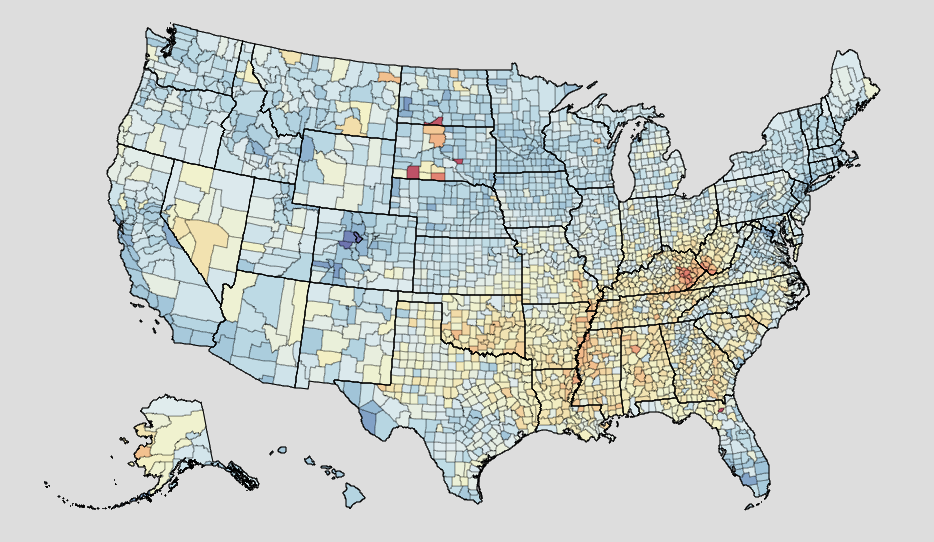National mortality rates are helpful if you want to learn about the US as a whole, but they don’t say much about the slew of ways people in particular locations died – the heart disease cases in Michigan, the HIV/AIDS in Florida, and the lung cancer in Kentucky.
To see those patterns, you need more granular data points.
The Institutes for Health Metrics and Evaluation has that information. Relying on 2014 government data, IHME offers an online tool that can sort mortality by cause of death, age, sex, location, or any combination of the four, all based on the number of deaths per 100,000 people. It reveals startling maps of where public-health funds may be needed most.
Here’s a sampling of the trends IHME data illuminates.
Heart disease

Heart disease is the leading cause of death in both men and women in the US. Roughly one in four Americans deaths, or about 610,000 fatalities in 2013, can be attributed to heart disease.
IHME divides heart disease into two types: rheumatic heart disease and ischemic heart disease (also known as coronary artery disease).
The lowest rate: 76.98/100,000 in Pitkin County, Colorado
The highest rate: 545.23/100,000 in Franklin Parish, Louisiana
Cancers

A cancer diagnosis used to be a death sentence, but increasingly there are a range of cancers that respond well to treatment. Since 1991, the death rate has fallen by 25%.
Rates still vary by cancer type and the stage of discovery, however.
The lowest rate: 70.71/100,000 in Summit County, Colorado
The highest rate: 503.5/100,000 in Union County, Florida
HIV/AIDS and tuberculosis

The US has made considerable leaps in the fight against HIV/AIDS fatalities. With the right treatment, people who are HIV-positive can expect to live as long as someone without the virus.
The lowest rate: 0.22/100,000 in Saint Croix County, Wisconsin
The highest rate: 65.67/100,000 in Union County, Florida
Neurological disorders

Neurological disorders include ailments like epilepsy, amyotrophic lateral sclerosis (ALS, or Lou Gehrig's disease), and Alzheimer's disease.
In the US, rates of death are generally higher on the east coast and in the southern states of Texas, Mississippi, and Alabama.
The lowest rate: 30.77/100,000 in Richmond County, New York
The highest rate: 198.1/100,000 in Madison County, Mississippi
Injuries

A collection of transport injuries; unintentional injuries; self-harm and personal violence; and forces of nature, war, and legal intervention form the general map of injuries that lead to death.
The lowest rate: 24.2/100,000 in Queens County, New York
The highest rate: 234.94/100,000 in Todd County, South Dakota
Self-harm and interpersonal violence

Filtering by people killing themselves and others, the view is similar to the map of general injury deaths, putting outliers South Dakota and Alaska in greater relief.
Alaska has the highest suicide rate in the US, and South Dakota has seen its violent crime rate double over the last decade.
The lowest rate: 7.48/100,000 in Sioux County, Iowa
The highest rate: 117.99/100,000 in Kusilvak Census Area, Alaska
Chronic respiratory diseases

Chronic respiratory diseases include things like asthma, chronic obstructive pulmonary disease, and asbestosis.
They generally affect people most often working in construction, in coal mines, and in otherwise pollutant-filled environments, like factories.
The lowest rate: 14.27/100,000 in Summit County, Colorado
The highest rate: 160.97/100,000 in Magoffin County, Kentucky
Coal workers pneumoconiosis

The most extreme cases of coal-related lung disease - coal workers pneumoconiosis - are rare and localized to one Appalachian county in Virginia: Buchanan County.
Residents in the region have one of the nation's highest adult disability rates in the country. Nearly 20% of people received government social security benefits in 2011, the most recent year for which data is available.
The lowest rate: 0.01/100,000 in Racine County, Wisconsin
The highest rate: 42.39/100,000 in Buchanan County, Virginia
Malignant skin melanoma

Perhaps unsurprisingly, the rates of malignant melanoma are highest in the sun-belt states cutting through the lower third of the US: Kentucky, Oklahoma, Texas, and Utah.
The melanoma trend even swings up north to parts of California, Oregon, and Washington.
The lowest rate: 0.98/100,000 in Aleutians West Census Area, Alaska
The highest rate: 7.24/100,000 in Union County, Florida
Non-melanoma skin cancer

The rates go down considerably for non-melanoma skin cancer, particularly for states on the west coast. Also known as squamous-cell carcinoma, it is far more common but less deadly than its malignant cousin.
In the past three decades, more people have had skin cancer than all other cancers combined.
The lowest rate: 0.38/100,000 in Aleutians West Census Area, Alaska
The highest rate: 2.6/100,000 in Union County, Florida
Neglected tropical diseases and malaria

A host of diseases that are deadly in developing countries, such as malaria, rabies, and dengue fever don't lead to nearly as many deaths in the US.
Modern medicine has managed to treat and prevent a host of diseases that arise from unsanitary living conditions.
The lowest rate: 0.02/100,000 in Charlotte County, Florida
The highest rate: 0.77/100,000 in Oglala Lake County, South Dakota
Life expectancy

All these disorders, diseases, and other causes of death coalesce into a look at overall life expectancy around the US.
Generally, this follows the trend of the disease maps: The south has worse rates than the northeast and west. Across the US, the average life expectancy is 78.8 years, according to the CDC.
The lowest age: 66.81 years Oglala Lakota County, South Dakota
The highest age: 86.83 years in Summit County, Colorado

